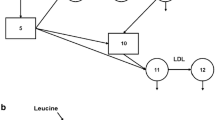Abstract
Previous in vitro radioligand binding data have shown that prostaglandin E1 (PGE1) increases the number and the binding affinity of low-density lipoprotein (LDL) receptors of the human liver. Experimental data in normo- and hypercholesterolaemic rabbits have confirmed these findings, showing a significant increase in LDL-binding to the liver in vivo after prolonged PGE1 therapy.
Methods: This study aimed to confirm the experimental and animal data in human in vivo. 123I-LDL binding to the liver was quantified in vivo in patients suffering from peripheral vascular disease, seven of them with heterozygous familial hypercholesterolaemia (HC) and five with normal total plasma cholesterol, after PGE1 administration (5 ng·kg−1·min−1; 6 h daily for 5 days/week for 5 weeks). LDL uptake by the liver was quantified by single photon emission computer tomography (SPECT).
Results: The amount of LDL trapped by the liver in normocholesterolaemics (45.6%) was significantly higher than in hypercholesterolaemics (22.0%). PGE1 induced an increase in liver LDL binding, which was more pronounced in HC (+38.2%) than in normocholesterolaemic patients (+8.11%).
Similar content being viewed by others
References
Muzya GI, Korobkova EN, Golovanova NK, Bergelson LD (1987) Influence of prostaglandins on the lipid transfer between human high density and low density lipoproteins. FEBS Lett 220:371–375
Manevich EM, Martynova MA, Muzya GI, Vodovozova EL (1988) The interaction of prostaglandins with serum low-density lipoproteins. Biochim Biophys Acta 963:302–310
Schwartz KE, Zaro B, Burton P, Hunt J, Pennely L, Sevelius H (1988) Reduction of serum lipoproteins in man by oral administration of a prostaglandin analogue (enprostil). Atherosclerosis 71:9–16
Sinzinger H, Kaliman J, Widhalm K, Pachinger O, Probst P (1981) Value of platelet sensitivity to antiaggregatory prostaglandins (PGI2, PGE1, PGD2) in 50 patients with myocardial infarction at young age. Prostagl Med 7:125–132
Ney P, Braun M, Szymanski C, Schrör K (1991) Antiplatelet, antineutrophil and vasodilating properties of 13,14-dihydro-PGE1 — an in vivo metabolite of PGE1 in man. Eicosanoids 4:151–155
Hajjar DP (1985) Prostaglandins and cyclic nucleotides: modulators of arterial cholesterol metabolism. Biochem Pharmacol 34:295–300
Sinzinger H, Virgolini I, Lupattelli G, Molinari E, Gerakakis A, Angelberger P (1991) Prostaglandin E1 decreases the low-density-lipoprotein entry into rabbit arterial wall. Br J Pharmacol 103:1626–1628
Virgolini I, Li SR, Lupattelli G, Pidlich J, Angelberger P, Banyai M, Sinzinger H (1991) Effect of prostaglandin E1 on low density lipoprotein apo-B, E-receptor binding in human, rat and swine liver in vitro. Prostaglandins 42:81–93
Sinzinger H, Virgolini I, Li SR, Gerakakis A, Fitscha P, O'Grady J (1993) Increase in in-vivo low-density lipoprotein (LDL) receptor binding after PGE1 and 13,14-dihydro-PGE1 treatment in rabbits. J Cardiovasc Pharmacol 21:503–506
Kaliman J, Kostner G, Kraupp O, Kunze M, Sinzinger H, Widhalm K (1987) Richtlinien zur Prävention der Atherosklerose. Wien Klin Wschr 99:589–590
MacFarlane AS (1958) Efficient tracer-labelling of proteins with iodine. Nature 182:53–55
Kannel WB (1971) Serum cholesterol, lipoprotein, and the risk of coronary heart disease. The Framingham Study. Ann Int Med 74:1–12
Ross R, Glomset JA (1976) The pathogenesis of atherosclerosis. N Engl J Med 295:420–425
Brown MS, Goldstein JL (1984) How LDL-receptors influence cholesterol and atherosclerosis. Sci Am 251:58–66
Brown MS, Goldstein JL (1976) Receptor mediated control of cholesterol metabolism. Study of human mutants has disclosed how cells regulate a substance that is both vital and lethal. Science 191:150–154
Steinberg D (1983) Lipoprotein and atherosclerosis. A look back and a look ahead. Arteriosclerosis 3:283–301
Vallabhajosula S, Goldsmith SJ, Ginsberg H, Badimon JJ, Le NA, Paidi M, Fuster V (1985) 99mTc-labelled lipoprotein metabolism and non-invasive imaging of atherosclerotic lesions. Eur J Nucl Med 4:198–201
Vallabhajosula S, Paidi M, Badimon JJ (1988) Radiotracers for low-density lipoprotein biodistribution studies in vivo: technetium-99-low-density lipoprotein versus radioiodinated low-density lipoprotein preparation. J Nucl Med 29:1237–1245
Lupattelli G, Virgolini I, Rauscha F, Sinzinger H (1991) Quantitative imaging of human liver low density lipoprotein (LDL)-receptor in vivo. In: Höfer R, Bergmann H, Sinzinger H (eds) Radioaktive Isotope in Klinik und Forschung. Schattauer, Stuttgart, pp 148–150
Lupattelli G, Virgolini I, Sinzinger H, Ciuffetti G, Siepi D, Orecchini G, Pistola L, Ventura S (1990) Studio in vivo del recettore epatico per le LDL mediante reiniezione di lipoproteine autologhe marcate con I-123. Giornale della Arteriosclerosi 15:127–132
Lupattelli G, Virgolini I, Li SR, Sinzinger H (1991) Low density lipoprotein receptors: preliminary results on “in vivo” study. Wien Klin Wschr 103:462–465
Virgolini I, Angelberger P, Lupattelli G, Li SR, Banyai M, Pidlich J, Sinzinger H (1991) Comparison of different methods for LDL-isolation and radioiodination on liver LDL-receptor binding in vitro. Nucl Med Biol 18:513–517
Peskar BA, Hesse WH, Rogatti W, Diehm C, Rudofsky G, Schweer H, Seyberth HW (1991) Formation of 13,14-dihydroprostaglandin E1 in patients with peripheral arterial occlusive disease. Prostaglandins 41:225–229
Sinzinger H, Rogatti W (1991) Prostaglandin E1 in der Therapie der peripheren arteriellen Durchblutungsstörung. Wien Klin Wschr 103:558–565
Willis AL, Smith DL, Viago C (1989) Suppression of principal atherosclerotic mechanisms by prostacyclin and other eicosanoids. Prog Lipid Res 48:1–22
Author information
Authors and Affiliations
Rights and permissions
About this article
Cite this article
Sinzinger, H., Virgolini, I., Kritz, H. et al. Prostaglandin E1 increases binding of 123I-low-density lipoprotein to the human liver in vivo. Eur J Clin Pharmacol 49, 515–520 (1996). https://doi.org/10.1007/BF00195940
Received:
Accepted:
Issue Date:
DOI: https://doi.org/10.1007/BF00195940




